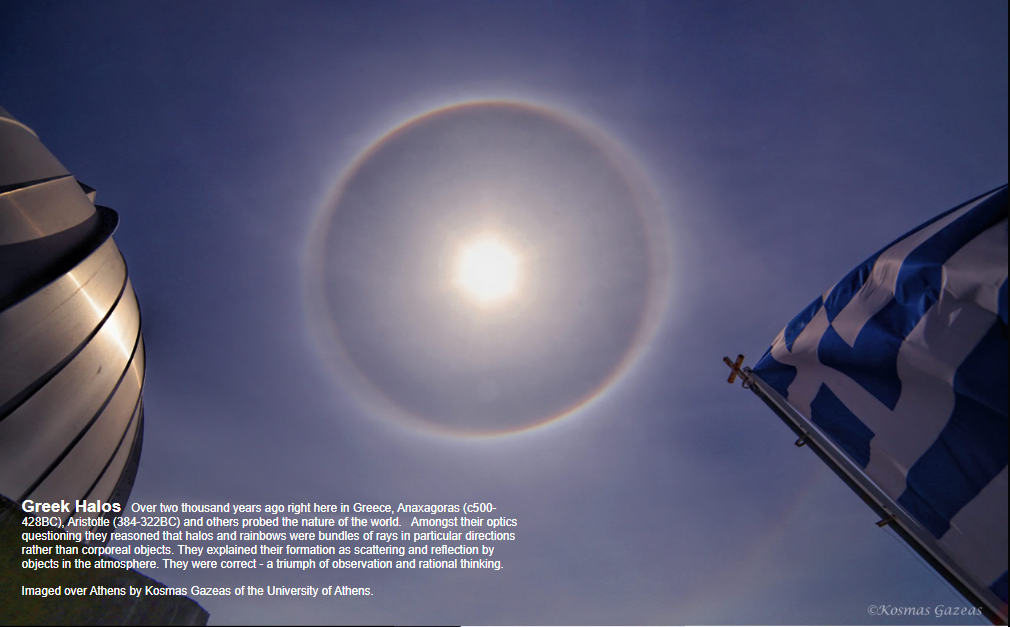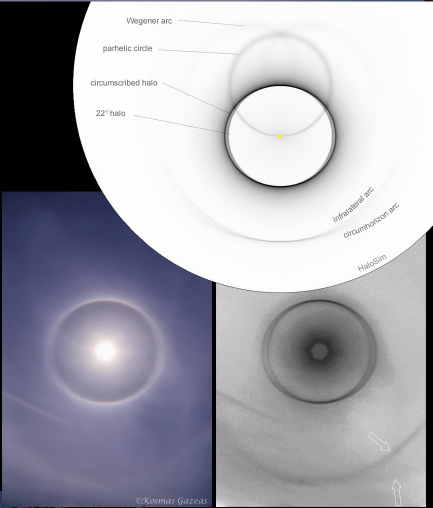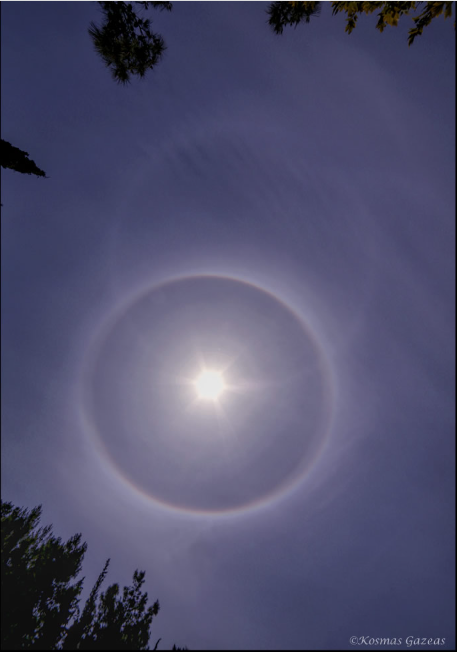Greek Halos - OPOD
Greek Halos - OPOD
Over two thousand years ago in Greece, ancient philosophers such as Anaxagoras and Aristotle delved into the mysteries of the natural world. Among their inquiries into optics, they pondered the nature of halos and rainbows, proposing that these phenomena were not physical objects but rather bundles of rays in specific directions. Remarkably, they correctly explained the formation of halos as a result of scattering and reflection by objects in the atmosphere. This early understanding stands as a testament to their powers of observation and rational thinking.
The Greeks, with their appreciation for geometry, would have been captivated by the intricate patterns of ice halos. These optical wonders showcase crystals in near-perfect polyhedral forms, etching precise arcs onto the sky. The geometries of ice halos are created by hexagonal prisms, which consist of long prisms with vertical end faces, short prisms (plates) with horizontal end faces, and randomly oriented prisms.
Closest to the sun is the common 22° halo, formed by randomly oriented crystals. Adjacent to it, above and below the sun, lies the circumscribed halo produced by column crystals. Interestingly, at a distance twice that from the sun, two more halos emerge. One of these halos can be faintly observed next to the Greek flag in the top image, while both are more clearly visible in the lower right images, with one enhanced through color subtraction. These halos comprise a section of a strong, nearly circular arc and a weaker arc extending further from the sun. The stronger arc may initially appear to be a 46-degree halo; however, its absence above the sun and its relatively weaker presence compared to the 22-degree halo formed by the same crystals suggest an alternative explanation. It aligns with an infralateral arc created by rays passing between the side and end faces of horizontal columns, a fitting interpretation supported by the HaloSim ray tracing simulation. The weaker arc that touches the infralateral arc, although its existence cannot be fully confirmed due to its appearance on only two images, is likely the circumhorizon arc, typically formed by horizontal plates.
While plate crystals typically give rise to sundogs or 22° parhelia, they did not appear over Athens during this observation because the sun was positioned too high in the sky to allow for their formation. However, one standout feature steals the spotlight: the small parhelic circle, best observed in the image below. This captivating circle is primarily formed by reflections from the end faces of the abundant horizontal columns. The relative weakness of the circumscribed halo suggests a scarcity of plates, which are typically the primary source of the parhelic circle.
In conclusion, these Greek halos, imaged over Athens by Kosmas Gazeas of the University of Athens, offer a glimpse into the fascinating world of atmospheric optics. They demonstrate the intricate interplay between light and ice crystals in the atmosphere, resulting in stunning geometric patterns etched upon the sky. The Greeks' early insights into the nature of halos and rainbows serve as a testament to their astute observations and rational thinking. Today, we continue to study and marvel at these optical phenomena, uncovering new layers of understanding and appreciating the beauty that lies within our atmosphere.

Greek Halos Over two thousand years ago right here in Greece, Anaxagoras (c500-428BC), Aristotle (384-322BC) and others probed the nature of the world. Amongst their optics questioning they reasoned that halos and rainbows were bundles of rays in particular directions rather than corporeal objects. They explained their formation as scattering and reflection by objects in the atmosphere. They were correct - a triumph of observation and rational thinking.
Imaged over Athens by Kosmas Gazeas of the University of Athens.

The Greeks would have loved the geometries of ice halos. Crystals in near perfect polyhedral forms and arcs of geometric precision scribed on the sky.
Hexagonal prisms formed this display. Long prisms with end faces vertical, short prisms (plates) with end faces horizontal and some prisms randomly oriented.
Nearest the sun is the common 22° halo from the randomly oriented crystals. Touching it above and below the sun is the circumscribed halo from column crystals.
Twice as far from the sun there are two more halos. One is just visible next to the Greek flag in the top image. They can be better seen in the two images at lower right one of which is enhanced by colour subtraction. There is a section of a strong almost circular arc and tangent to it a much weaker arc extending further from the sun. The stronger arc might be interpreted as a 46 degree halo. However, there is no sign of it above the sun and the 22 degree halo formed from the same crystals is comparatively weak. An infralateral arc formed by rays passing between the side and end faces of horizontal columns fits the images. It also appears naturally in the HaloSim ray tracing at right using just enough horizontal columns of medium length to make the circumscribed halo and parhelic circle. The weaker arc touching the infralateral (it appears on two images but we cannot be wholly certain of its existence) is the usually more frequent circumhorizon arc made by horizontal plates.
Plate crystals of course give sundogs or 22° parhelia but they did not appear over Athens because the sun was too high to allow them to form.
A star of the show is the small parhelic circle seen best in the image below. It was mostly formed by reflections from the end faces of the plentiful horizontal columns. The weakness of the circumscribed halo suggests a scarcity of plates, the more usual major source of the parhelic circle.

Note: this article has been automatically converted from the old site and may not appear as intended. You can find the original article here.
Reference Atmospheric Optics
If you use any of the definitions, information, or data presented on Atmospheric Optics, please copy the link or reference below to properly credit us as the reference source. Thank you!
-
<a href="https://atoptics.co.uk/blog/greek-halos-opod/">Greek Halos - OPOD</a>
-
"Greek Halos - OPOD". Atmospheric Optics. Accessed on April 19, 2024. https://atoptics.co.uk/blog/greek-halos-opod/.
-
"Greek Halos - OPOD". Atmospheric Optics, https://atoptics.co.uk/blog/greek-halos-opod/. Accessed 19 April, 2024
-
Greek Halos - OPOD. Atmospheric Optics. Retrieved from https://atoptics.co.uk/blog/greek-halos-opod/.